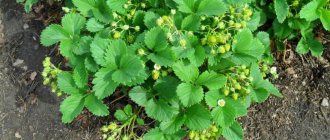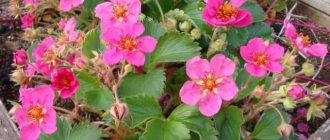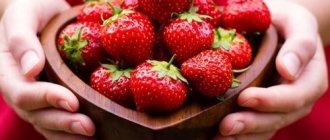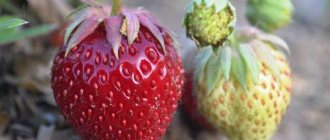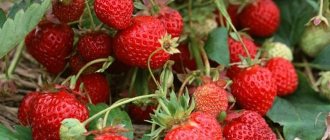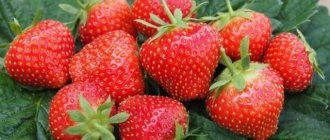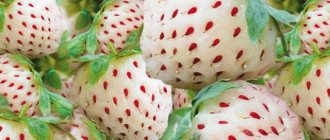- What is the difference between wild strawberries and wild strawberries?
- The best varieties
- Predecessor of strawberry
- Selection of planting material
Strawberries and wild strawberries are 2 different types of plants that belong to the same family Rosaceae, the genus Strawberry. They are different in appearance, have different tastes, and different ripening periods. Next we will describe in detail how strawberries differ from wild strawberries.
What are strawberries
Strawberries, which are grown in gardens, have two varieties:
- garden;
- musky.
Strawberries grow in the wild:
- forest;
- meadow
Strawberry is a small bush (20-30 cm in height) with fibrous roots. Over time, the rhizome grows widely around, forming young growths (horns) every season.
Strawberries have three types of shoots:
- The annual stem is a horn. In spring, the horn grows rapidly and turns into a miniature berry bush with a flower bud on the top and a rosette of several leaves.
- Flowering shoots. They grow in the second season from a flower bud. A flower and a berry are formed on them.
- Mustache. They begin to grow actively after flowering ends. A daughter rosette is formed on the antennae. Moreover, initially it just hangs in the air without roots (then touching the ground they begin to take root). Then a whisker grows again from the first rosette and a daughter of the second order appears on it. The process continues with rosettes of the third order, etc. If you stop controlling the spread of the tendrils, the plant is capable of covering the entire area with a carpet, since one plant can produce from 20 to 100 such shoots in a season. Therefore, during the entire growing season, you should cut off the mustache 4-5 times.
What are strawberries
The bright green leaves are ovate, toothed, and heavily pubescent with hairs. Flowers are collected in inflorescences of 5-12 flowers, depending on the age of the bush. The buds themselves are quite large (2.5 cm in diameter), unisexual. Pollination depends entirely on insects. From flowering (May) to harvesting (June) it takes only 2-2.5 months.
At the time of planting, a young seedling has 2-4 horns, and by the end of the season it has about 10 of them. Old bushes can have 30 or more of these horns. The yield depends on the number of horns.
Description and differences between meadow and forest strawberries
Wild strawberries grow in the forest, closer to the edge (where the sun peeks). Its fruits begin to ripen early, by the end of June. The ripe berry has very tender, red flesh and a rich musky honey aroma. Moreover, even unripe berries smell. The ripe berry is easily removed from the stalk, so the crop does not need to be peeled again. The berries have many hard seeds. Due to excessive softness, the berries are prone to caking. Therefore, it would be correct to collect them in wide baskets.
Wild strawberries can be successfully grown in a summer cottage. It takes root well and grows in shaded areas. It is undesirable to plant wild berries next to their cultivated relatives, as they can be pollinated, which will affect the quality and quantity of the harvest of garden hybrids.
The berry is rich in many useful substances and microelements:
- iron;
- pectin (up to 1.7%);
- tannins (up to 0.25% in leaves and up to 9.4% in roots);
- ascorbic acid (about 90 mg 100 g);
- carotene;
- copper;
- manganese;
- zinc;
- chromium.
Wild strawberry
A close relative of the forest strawberry, the meadow strawberry, grows in sunny meadows. It tastes sweeter than forest and has no bitterness. The berries are round, weighing about 2 g. Until fully ripe, the calyx fits tightly around the fruit, and in a ripe berry it turns outward. It is better to pick berries that are not quite ripe, but for now their color is pink with white and greenish spots. But it should be understood that the berries are picked together with the stalks, after which the collected fruits are sorted and cleaned. The ripe berry has a burgundy-red color. The transportability of meadow strawberries is higher than that of forest strawberries. In appearance and taste, the berry resembles garden strawberries.
What can we find in nature
So, we found out that wild strawberries (common strawberries) and green strawberries are widespread in our wild nature. It is rare to see European Strawberries (musk, forest). The last two plants, in fact, in botanical nomenclature also belong to the genus Strawberry (Z. green and Z. musk, also known as European or forest).
But, as already mentioned, there are more species of the genus Fragaria, currently 16 of them have been identified. In addition to the three described above, there are others in Russia, but there are fewer of them, their range is narrower and some can be seen only in limited areas. Nevertheless, let's get to know them.
- Oriental strawberry – Fragaria orientalis. On our territory it grows in Eastern Siberia and the Far East in forests, open mountain slopes, often on rocky substrate. Distinctive features: the petals of the flower come one after another, each leaflet is a trifoliate leaf on a very short petiole (almost sessile).
Fragaria orientalis.
- W. plain – F. campestris. Its habitat is in the southern part of the country: in the Crimea, in the Caucasus, in the East. Siberia. It differs from green strawberries only in the protruding pubescence of the peduncles and the achenes deeply immersed in the pulp.
Fragaria campestris.
Feral cultivated varieties can also be found in forests and other suitable habitats. Their appearance in nature is understandable: many birds love berries and, by eating them, contribute to their spread. Under suitable conditions, seeds that have passed through the gastrointestinal tract of birds germinate. The yield of such specimens will be less, because in nature no one fertilizes the soil, loosens the ground, removes the tendrils or weeds out the surrounding grass.
Difference between strawberries and wild strawberries
Strawberry First-grader - description of the variety
These two berries differ in the following parameters:
- strawberries are unisexual (bushes can be either male or female), and strawberries are bisexual (one bush has both male and female flowers);
- the sepal of strawberry very easily comes away from the berry, but in strawberry it is firmly attached to the fruit;
- ripe strawberries are entirely red, very sweet and aromatic, and the strawberry inside is always white, even if the outside is bright burgundy, and the berry itself is sour;
- Strawberry fruits are very soft, while strawberries hold their shape well and are well transported.
Strawberries also produce much fewer runners and, accordingly, are less productive.
What is the difference between wild strawberries and wild strawberries?
Wild strawberries (or nutmeg strawberries) grow in the forest on the edges or along roads. The bushes are low (about 12 cm in height), almost barbelless. The fruits are spherical and small. The color of the berries is pink, turning to red at the top. There are also pale yellow varieties. The smell is weak, nutmeg. Whereas strawberries have red, somewhat elongated fruits with a very rich aroma. And the bushes themselves are twice as tall.
Wild strawberry
The difference between strawberries and garden strawberries
Garden strawberries can be distinguished from strawberries by the size of the berry. For example, the Victoria variety: its fruits are 10 times larger than strawberries. Unlike strawberries, garden strawberries produce more runners. The attachment of the sepals is also different. In the first one it sits tightly on the berry. These species also have different generic characteristics.
So what are the differences?
So why did it happen that the miraculously obtained berry displaced Fragaria moschata from European gardens?
High yields, large fruit, excellent taste of berries, sugar content. Of course, the first varieties bred were not as perfect as modern new breeding products, but they were superior to the previously cultivated strawberries in basic parameters. Garden strawberries quickly occupied their niche, gained popularity among gardeners, and breeders rushed to study and develop new varieties and hybrids of the crop.
Fragaria ananassa appeared in Russia in the 19th century and immediately became a very popular crop. But only foreign varieties were grown, and only in the mid-20s of the 20th century did research begin, Soviet and then Russian scientists began breeding.
So garden strawberries from wild strawberries (see table and video):
| Signs | Garden strawberry Fragaria ananassa | Strawberry Fragaria moschata |
| Plants | The bushes are small, up to 25 cm in height, the stems are located in the center. The peduncles are not too tall, the flowers are “camouflaged” under the leaf blades. | Perennial, tall bushes, up to 40 cm in height, few tendrils (usually in young plants). Peduncles are straight, rise and rise above the leaves (see photo) |
| Leaves | The corrugation is weakly expressed, the color is rich green. Size – medium. The edges of the leaf blades are serrated. Leaves grow on the sides. There is a characteristic strawberry aroma. | Heavily corrugated, large plates, normal color, light green |
| Flowers | Bisexual, number of petals – five, color – white. Hybrids with pink flowers have been bred. No barren flowers. | Dioecious plant, has male and female flowers. In size – large (up to 2.5-3 cm in diameter), with spaced sepals |
| Berries | Various shapes (round, heart-shaped, comb-shaped, elongated), fleshy. In diameter - from 2 to 7-8 cm (depending on the variety). When cut, the flesh is scarlet, pink, red, there is no core. The achenes are greenish, golden, dark red, either on the surface or depressed. Yields are high. Keeping quality and transportability depend on the characteristics of the variety or hybrid | Elongated, from 0.3 to 2 cm in diameter. When cut, the pulp is speckled with white, the core is visible. The achenes are slightly pressed on the outside, on the surface. The fruits are poorly separated from the receptacle. Productivity is low. Suitable for transportation, holds its shape well |
| Taste | Sweetness and sugar content are well expressed. A number of varieties have specific aromas (citrus, strawberry, pineapple) | With well-defined sourness, slightly muted aroma |
They can be distinguished not only by external characteristics, but also by genetic characteristics. One of the main differences is the different number of chromosomes among crops: strawberries have 2n=42, and garden strawberries have 2n=56. But this recognition method is only available to breeders; the average gardener is rarely interested in such subtleties.
The cultivation technology is complex, although the crop itself is unpretentious and resistant to cold weather, and grows well in the shade. But due to the fact that strawberries are part of the group of dioecious plants, replanting a certain number of male bushes is required to obtain a harvest.
It is important to maintain the number of “men”, otherwise even female bushes will not produce berries, and there will be only empty flowers. Gardeners note that female plants are quickly absorbed by male plants, which leads to a sharp drop in yield.
Strawberries are grown on a large scale in Holland and France, while in Russia varieties and hybrids of garden strawberries are more popular. Plants adapted to difficult climate conditions, with proper care, produce stable yields, and gardeners can choose from a huge range of species.
We hope that this information was useful, and it’s up to you to decide what to grow in your own summer cottage. It is quite possible that someone will be interested in real strawberries, and varieties (seedlings or seeds) can be ordered in specialized stores.
Natalia Severova
Strawberry-strawberry hybrid
When strawberries ripen
Zemklunika is the name given to a hybrid of strawberries and wild strawberries. It was bred by a domestic breeder - Kantor Tatyana. It was possible to obtain a plant with the best properties of the “parents”. The fruit, like a strawberry, is sweet and aromatic, like a strawberry, large and dense. It was also possible to adjust winter hardiness and disease resistance.
The bushes turned out to be similar to strawberry bushes, but much more lush and larger. Very good yield - up to 1 kg of berries per bush.
The best varieties
The most popular varieties today:
- Anastasia;
- Diana;
- Strawberry;
- Chit;
- Merchant's wife;
- Muscat Biryulevskaya;
- Nadezhda Zagoriya;
- Penelope;
- Raisa;
- Report;
- Student;
- Candied Nutmeg.
Of the above varieties, the largest-fruited one is Kupchikha. The hybrid needs good lighting and frequent watering. Due to the size of the bush, plantings should be less frequent than the parent plants.
Zemklunika
In 2021, new high-yielding varieties were developed, such as:
- Alba;
- Christina;
- Honey.
The best late-ripening varieties
Breeders are working tirelessly to extend the fruiting period of strawberries. The demand for late-ripening species is justified by the extension of the period of consumption of fresh berries until late autumn. Growing berries of different ripening periods on the plot promotes year-round production of strawberries. Late-ripening forms of strawberries with a high level of productivity are considered especially valuable: Zenga Zengana, Cinderella, Talisman, Mitze Schindler, Troubadour, Red Gauntlet.
Zenga Zengana
Garden strawberry Zenga Zengana
Late-ripening strawberry Zenga Zengana has compact and productive bushes. Berries weighing up to 20 grams, when ripe, acquire a dark cherry hue.
Garden strawberry Cinderella
The large-fruited late variety Cinderella has a powerful root system and tall bushes. The large berries of this species are famous for their pleasant dessert taste.
Mascot
Strawberry Talisman
Winter-hardy, with good yield, species. Bears fruit for 2 years without transplanting.
Mitze Schindler
Garden strawberries Mitze Schindler
Low-growing Mitze Schindler strawberry bushes produce small, dark red fruits. Small berries stand out against the background of large fruits with excellent taste. They are often compared to wild berries.
Troubadour
Strawberry Troubadour
The Troubadour variety, bred in the UK, produces abundant medium-sized berries. Each weight is about 7 grams. The strawberries taste juicy and moderately sour.
Red Gauntlet
Strawberry Red Gauntlet
It has a vigorous, compact bush. The berries are red-orange. Tasting rating on a five-point scale: 4.2 points.
Late ripening strawberries have differences in color, berry shape and taste.
Raspberry with strawberry flavor
Strawberry Victoria
There cannot be a hybrid of raspberries and strawberries. Strawberries are herbaceous plants, and raspberries are shrubs. But in East Asia, a variety of raspberries with strawberry flavor grows under natural conditions - this is strawberry-raspberry. She also owns the following names:
- seductive;
- Chinese;
- Tibetan;
- Himalayan;
- strawberry;
- strawberry;
- dwarf;
- rosaline or roseleaf.
In addition to the pleasant taste of the berries, the bush itself has decorative value. It has beautiful rose-like leaves and lovely large white flowers. This variety is characterized by the simultaneous presence on the bush of both flowers and large bright pink fruits that taste like strawberries. True, the berries are not suitable for transportation and therefore it is almost impossible to find them on sale.
What are green manures?
Green manures are plants that are capable of growing green mass several times per season. The tops are mowed and left in place, they rot and enrich the soil. Each crop has its own green manure.
Plants have the following influence on the soil:
- improve the quality of soil structure;
- prevent the growth of weeds;
- enrich the soil with the elements necessary for subsequent plantings;
- promote the proliferation of necessary microorganisms;
- saturate the soil with humus;
- free the earth from pathogenic microbes and pests.
What are strawberry green manures?
Predecessor of strawberry
In a limited garden plot, it is difficult to maintain crop rotation or even leave some part of it fallow. We have to look for other ways to restore depleted land. This also applies to planting garden strawberries. In one area, it bears maximum fruit within 4-5 years. Then the berry bed needs to be updated. But before that, a new site should be prepared. These can be beds after:
- beans or other legumes;
- parsley or celery;
- garlic and onions;
- carrots, radishes or corn.
Interesting! To save space in your garden plot, it is very convenient to plant strawberries in car tires. They are installed in tiers. In addition to saving space, the yield increases and the care of plantings becomes easier.
Green manure for garden strawberries
It is recommended to first grow green manure at the intended planting site for garden strawberries.
For garden berries, the best solutions to this problem are:
- rape;
- lupine;
- radish;
- buckwheat;
- Vika;
- phacelia;
- oats;
- mustard.
Green manure for garden strawberries
During the summer, the planted crop should be mowed several times, and there is no need to remove the grass. Just as it rots, it will enrich the soil with humus. It will be even better if several different crops are planted on the site in turn during the season, each of which will perform its own function. For example: legumes release nitrogen, mustard and rapeseed release phosphorus, buckwheat release potassium.
Note! Mustard and rapeseed are good phytosanitary plants, oats cope remarkably well with nematodes, and calendula and marigolds cope with verticillium.
A lightweight option for preparing a site for planting berries
There is also an accelerated option to prepare a site for planting berry crops. To quickly restore the soil, you can immediately sow some kind of green manure crop immediately after harvesting Solanaceae and mow it several times before winter; you can also uproot an old berry bed and sow it with fast-growing green manure.
Strawberry plantation - mulching with film.
An excellent way to make it easier to care for your plantation and increase the yield of berries, which should not be neglected, is mulching with film. What happens?
- The film increases the soil temperature by 3-5 degrees.
- The structure of the soil is preserved.
- Water is saved because moisture is retained under the coating.
- The growth of weeds slows down, while cultivated bushes, on the contrary, accelerate their development.
- The berry harvest does not come into contact with the ground.
Different types of films give slightly different effects:
- Black - absorbs the sun's rays, stops the development of weeds, but is capable of “warming up” the soil so much that the berry bushes can burn out;
- Transparent - capable of warming the soil, does not heat up as much as black, minimizes the risk of plants burning out, but does not interfere with the development of weeds under it;
- Black and white two-layer - the most optimal mulching option, the upper white layer reflects part of the sun's rays without heating up much, the lower black layer accumulates a sufficient, but reduced amount of heat penetrating through the upper layer, while preventing the growth of weeds;
- Polyethylene reinforced - three-layer material of excellent strength, durable, resistant to difficult weather conditions.
To obtain high yields of large-fruited strawberries, it is necessary that the final planting density be no more than 25 plants per 1 square meter. m. In addition, it is important to monitor the age of the plantation: the life of the plants on it is 3-4 years, then a complete renovation is required.
Strawberry Neighbors
When planting different crops, their proximity should be taken into account, since plants can interfere with each other’s full growth and development, or they can also have a beneficial effect.
Garden strawberries respond well to proximity to garlic, parsley, and marigold flowers. You should not plant raspberries in close proximity. Over the course of a season, she grows many root shoots that will sprout in the strawberry bed. In addition, they will take moisture and nutrients from the berry bushes.
Is it possible to plant strawberries next to strawberries? Plants can be planted next to each other. Without scientific intervention, they will not pollinate among themselves. But if they are close together, they can germinate on each other’s territory with the help of their mustaches.
Strawberry Victoria
Use of berries and leaves in folk medicine
It's no secret that folk remedies are often the most effective. The leaves and fruits of wild strawberries and garden strawberries are used equally widely in folk medicine. A healing infusion is prepared from the berries, which acts as a general tonic.
Strawberries, wild strawberries and their leaves have multiple properties
, which are not only tasty, but full of vitamins. Jam can be consumed by both adults and children. In some cases, these berries can cause allergies. The leaves, which contain beneficial substances, are practically not contraindicated for anyone.
Wonderful berries, both wild strawberries and garden strawberries, are probably known to almost everyone in our country and far beyond its borders. It’s worth putting a little effort into collecting and caring for it at home, and every housewife will have an excellent medicinal and tasty remedy that helps against most diseases all year round.
Gardeners' experience in growing strawberries Victoria
Gardeners advise adding one new bed each year when planting. After five years, the first plantings are uprooted and will no longer produce a harvest. Thus, at the same time there will be 5 plantings of different ages in the garden. Of these, 3- and 4-year-old berries are the most productive.
Selection of planting material
If you plan to plant a garden bed with your own planting material, you need to stake out more productive bushes in advance. Plants with many large and uniformly sized fruits are the most productive. This is where you should take the mustache for your new garden bed. As soon as suitable material appears, it is immediately transplanted. The best sockets are of the first order. The second and subsequent daughters will be weaker. But they also take root, especially if transplanted in June-July.
Important! When planting a young bush, the growing point should be level with the ground.
Nutritional value
The fruits of the berries are very healthy. In folk medicine, strawberries and wild strawberries are used to treat a variety of diseases. Strawberries are valued as a berry that strengthens the immune system. Strawberries boast anti-inflammatory properties.
The medicinal properties of fruits depend on their chemical composition.
Strawberries contain:
- acid of plant origin - 1.5%;
- sugar - 9%;
- pectins - 1.4%.
Strawberries contain:
- a large amount of vitamin C, thanks to which the berry is endowed with antiviral and anti-inflammatory properties;
- folic acid;
- mineral components - magnesium, iron, calcium, etc.
In folk medicine, berries are used as an additional source of beneficial microelements and minerals. If you regularly include wild strawberries in your menu, this will be an excellent preventive measure against heart disease.
Berry juice is used in cosmetology. Due to its anti-inflammatory, wound-healing and rejuvenating properties, strawberry juice is used to combat early wrinkles and other facial skin defects.
Strawberry juice helps heal wounds and abrasions, since the structural composition of the juice contains wound-healing and regenerating components.
The leaves of the plant also have therapeutic properties. For example, a decoction of strawberry leaves is used to reduce fever, normalize blood pressure, and reduce nervous excitability. Strawberry leaves are used less frequently in folk therapy; they are used to prepare decoctions that help care for the skin of the face and body.
